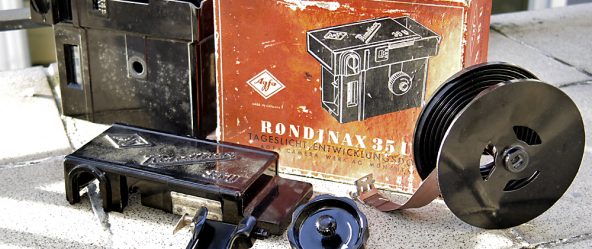Develop your own film
Posted by vonnagy on Sep 21 2020, in parahanga, Photography, rondinax, rondinax manual, rondinax review

[Note: this was an unpublished article from Jan. 2015 I had on Hubpages, I’ve decided to go ahead and publish it here with a few minor corrections]
Why not develop your own film?
As an avid film photographer, I am quite happy to see rebirth of analogue photography such as Polaroids (see my related article on choosing Polaroid Cameras). However, a recent purchase of Holga Camera left me scratching my head. The instruction said to take the film to Lab to get developed. One of the great joys of film photography is developing your own film negatives. Its every bit of fun as taking the photo!
Sadly, more emphasis is placed on taking the photo and entirely neglected on the developing the photo. Would you really trust a lab with your treasured photos? The myth is that developing film negatives is a hard process and requires a darkoom. The fact is, that is its a fairly simple process. In fact it sometimes less time and effort to develop a batch of film that it takes to grade some digital photos in photoshop! And with certain film development tanks you don’t even need a darkroom.
One of the most amazing experiences of photographer that I’ve experience was developing my own negatives. Its quite a magical feeling to know that blank roll of film has now produced images that you’ve taken!
Here are some simple things you’ll need to get started, aside from the chemicals and development tank, the rest of the items are household.
- A roll (or rolls) of exposed film
- A Development Tank or Daylight Box like the Rondinax
- Chemicals (can be bought individually, or in kits).
- Running Water
- Fridge (for cooling chemicals – black and white film)
- Hot Water (for warming chemicals – colour film)
- A thermometer
- Beakers/Measuring Cups for chemicals
- Bulldog clips to hang your negatives.
Here are some other things to consider about film development
- You can not ship film chemical outside of the USA, which is not problem if you live the USA. If you live outside of the USA, I found that the United Kingdom is a very good source for chemicals. Regarding shipping from the USA, the above what most photographic stores have told me; however I think it has to do more with volatility of certain chemical compounds such as silver nitrate and other potentially unstable compounds. I
- Though the principles of developing black and white and colour films are the same, colour film requires more rigorous temperature control.
- You can reuse the chemicals, although each use degrades your chemicals.
Black & White vs Colour Development
What I am about to say is a simplification, as there are more than one to skin a cat, or do film development. Below is very general, as to give an overview. ALWAYS read the directions on chemical themselves.
Black and White is the simplest film to development as you only need cool water – this is typically between 20 and 22 degrees Celcius (68 to 72 degrees Fahrenheit). Generally its:
- Place film in light proof box
- Pour in the developer and agitate at the right temperature for set time. This is what actually exposes the film.
- Pour in the fixer and agitate at the right temperature for set time. This is what stops development and sets the image
- Final Rinse and let negatives dry.
There are several variations to the above. When I did my first roll of black & white film I actually skipped step three because I had no fixer. There are several different types of chemicals. Also there are several protective rinses you can use after final rinse.
Developing with colour film is similar, but may have extra steps. Below is for common colour negative film known as C-41. The difference being that this uses hot development temperatures instead of cold.
I feel that there is alot of misinformation about colour film; most forum experts scream that if you don’t get your development done at 36 degrees your film will fall into shambles. I’ve development hundreds of rolls over the past few years and found that colour film is very very forgiving. Yes – don’t get sloppy and go for a few degrees off the mark. I but I found that that up to 2 degrees off the prescribed instructions will still render quality results!
[note this is where the originally article ends (I just ran out of steam!), however I would encourage you to check out my article ‘Zen and the art of Rondinax Developing‘]